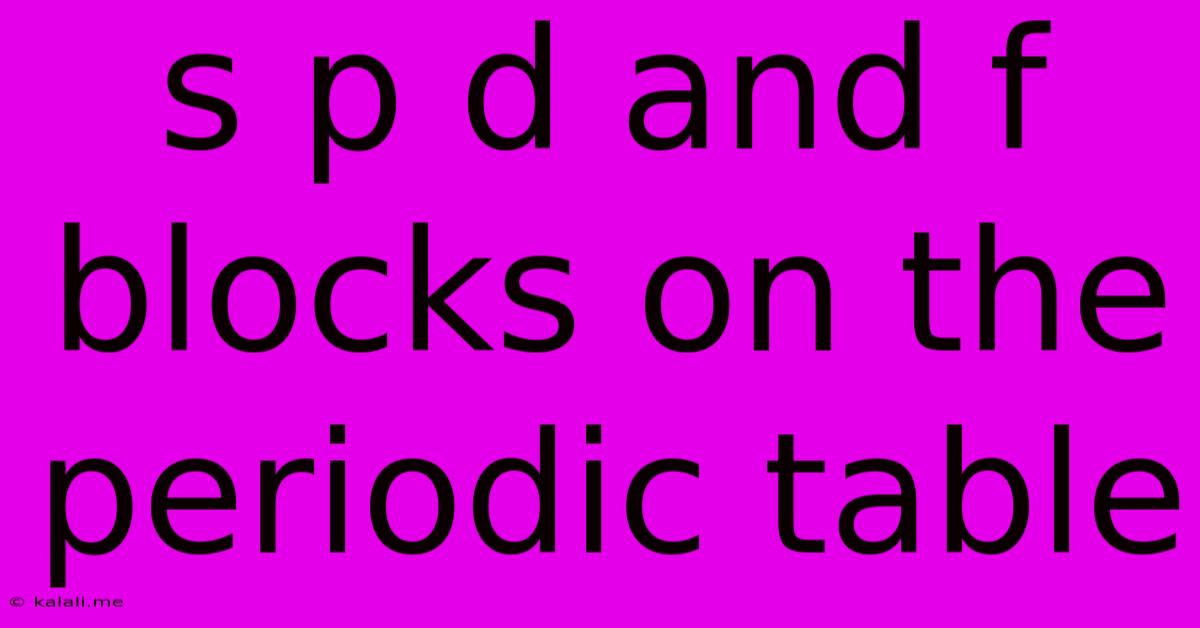S P D And F Blocks On The Periodic Table
Kalali
Jun 12, 2025 · 3 min read

Table of Contents
Understanding the s, p, d, and f Blocks of the Periodic Table
The periodic table is a cornerstone of chemistry, organizing elements based on their atomic structure and properties. A crucial aspect of understanding the table lies in comprehending the s, p, d, and f blocks, which represent the different electron orbitals where electrons reside. This article will delve into each block, exploring their characteristics, electron configurations, and the trends observed within them.
The arrangement of elements within these blocks directly relates to their valence electrons, the electrons in the outermost shell that participate in chemical bonding. Understanding these blocks is key to predicting chemical reactivity and properties.
The s-Block Elements: Alkali and Alkaline Earth Metals
The s-block occupies the first two columns of the periodic table. It encompasses the alkali metals (Group 1) and the alkaline earth metals (Group 2). These elements are characterized by their relatively low ionization energies, meaning they readily lose electrons to form positive ions (cations). This makes them highly reactive, especially the alkali metals.
- Key characteristics of s-block elements:
- Relatively low electronegativity.
- Low ionization energies.
- Tend to form ionic compounds.
- Generally exhibit +1 (alkali metals) and +2 (alkaline earth metals) oxidation states.
- Show a clear trend of increasing reactivity down their respective groups.
Examples of s-block elements include lithium (Li), sodium (Na), magnesium (Mg), and calcium (Ca).
The p-Block Elements: A Diverse Group
The p-block elements occupy groups 13-18, forming a large portion of the periodic table. This block includes a diverse range of elements exhibiting a wide variety of properties. While some are metals, others are nonmetals, and some are metalloids (semi-metals), bridging the gap between metals and nonmetals.
- Key characteristics of p-block elements:
- Variable electronegativity and ionization energies, leading to diverse chemical behavior.
- Can form covalent and ionic compounds.
- Exhibit a wide range of oxidation states.
- Include many essential elements for life, such as carbon (C), nitrogen (N), oxygen (O), and phosphorus (P).
The p-block encompasses elements like boron (B), aluminum (Al), carbon (C), silicon (Si), nitrogen (N), phosphorus (P), oxygen (O), sulfur (S), chlorine (Cl), and the noble gases (He, Ne, Ar, Kr, Xe, Rn).
The d-Block Elements: Transition Metals
The d-block elements, also known as transition metals, are found in groups 3-12. These elements are characterized by their ability to form multiple oxidation states and colored compounds due to the presence of partially filled d orbitals. Many are known for their catalytic properties and are essential in various industrial processes.
- Key characteristics of d-block elements:
- Variable oxidation states.
- Formation of colored compounds.
- Good conductors of heat and electricity.
- Many are hard and have high melting points.
- Often exhibit catalytic activity.
Examples include iron (Fe), copper (Cu), zinc (Zn), titanium (Ti), and chromium (Cr).
The f-Block Elements: Lanthanides and Actinides
The f-block elements, located at the bottom of the periodic table, are divided into the lanthanides and the actinides. These elements have their outermost electrons in the f orbitals. They generally exhibit similar chemical properties within their respective series. Many actinides are radioactive.
- Key characteristics of f-block elements:
- Similar chemical properties within each series (lanthanides and actinides).
- Most are radioactive (actinides).
- Often exhibit +3 oxidation state.
- Used in various applications, including lighting and nuclear technologies.
Examples include cerium (Ce), lanthanum (La) and uranium (U), plutonium (Pu).
Conclusion: The Importance of Understanding Block Classification
Understanding the s, p, d, and f blocks is crucial for comprehending the periodic table's organization and predicting the chemical behavior of elements. The differences in electron configurations directly influence the properties and reactivity of elements, leading to the diverse array of chemical compounds and phenomena observed in the world around us. By grasping the fundamental characteristics of each block, we gain a deeper appreciation for the underlying principles governing the behavior of matter.
Latest Posts
Latest Posts
-
Three Phase Induction Motor Circuit Diagram
Jun 13, 2025
-
How To Subtract Two Columns In Excel
Jun 13, 2025
-
How To Print The Act Admission Ticket
Jun 13, 2025
-
The First Step In Decision Making Is To
Jun 13, 2025
-
Si Unit For Volume Of A Liquid
Jun 13, 2025
Related Post
Thank you for visiting our website which covers about S P D And F Blocks On The Periodic Table . We hope the information provided has been useful to you. Feel free to contact us if you have any questions or need further assistance. See you next time and don't miss to bookmark.